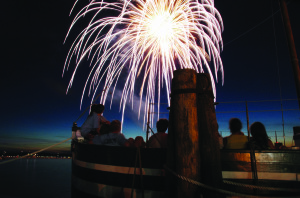
Lying in his bunk in the forecastle of the canal schooner Lois McClure, Len Ruth is rocked to sleep by the gently lapping waters of Lake Champlain. But even as his consciousness fades, the 47-year-old man from Fort Ticonderoga, N.Y., keeps one ear open.
“You’re always listening for noises you haven’t heard before – trickling water, or changes in the wind,” Ruth said.
Either sound could prove the first notes of a nightmare, the likes of which sent two other canal schooners, the General Butler and the O.J. Walker, to the bottom of Burlington Bay, where they rest still.
“The Butler was coming into Burlington, carrying 60 tons of marble, when she was caught in the storm of the century,” Ruth said, describing the first of the two wrecks as it occurred in 1875. “Her steering broke, and she crashed into the breakwater.
“Everyone on board managed to escape onto the breakwater before she went down.”
The O.J. Walker met its demise 20 years later due to a critical mistake: Its cargo of bricks and roofing tile was stored above deck rather than below, which made the schooner top heavy and caused it to roll over in rough water during a heavy gale.
“It happened so fast that the crew didn’t have time to grab the oars for the lifeboats,” Ruth said. “They had to drift ashore.”
The wrecks of those two 19th-century vessels, both located within a mile of where the Lois McClure now sits docked at Perkins Pier, provided the blueprint for the rare canal schooner when its construction began in 2000. Completed four years later, “The Lois” – as she is lovingly referred to by Ruth – now serves as a floating exhibit for the Lake Champlain Maritime Museum.
The Lois features the general deck configuration of the Butler, along with the mast setup of the Walker. The latter is what makes such a vessel unique: the ability to hoist sail and move freely with the wind, rather than having to hitch a ride on a tugboat.
“Similar boats were used in places like Holland and England, but were rare in this country,” said Ruth, who lives on the boat and serves as its curator and tour guide. “It made sense for Lake Champlain because there is enough open water to sail.”
Sitting in a chair on the deck of the Lois on a breezy August day, Ruth sized up the sailing conditions as close to perfect.
“Today would be a wonderful day to go north, with the south wind,” he said. “We’d be moving right along.”
Walking the Planks
Len Ruth’s nautical journey began with a choice faced by many throughout history: A ship or a cell. Bad behavior fueled by alcohol, drugs and bad checks left him in hot water with the law at age 22. A judge sent him to the job corps in Vergennes, where someone recognized that his woodworking experience might prove a good fit for the Maritime Museum.
“They were looking for someone who could pound a nail and sweep a floor,” Ruth said, “and I was lucky enough to take advantage of it.”
Ruth’s introduction to the museum’s work was helping to build a replica of a Revolutionary War-era gunboat, the Philadelphia II. He was immediately struck by the sheer amount of craft involved.
“You can’t just go out and buy a 20-foot oar; you have to make it yourself,” Ruth said. Looking down, he pointed with his foot at a wooden cleat securing a rope on the deck of the Lois. “That had to be made by hand. It’s a lot of work.”
Ruth has spent more than a decade living on board the Lois, and said hard work has been his one constant companion. From fetching and loading supplies while in port to hoisting the sails to head out into open water, the schooner demands a never-ending series of tasks.
“You don’t really know what that means until you do it,” Ruth said. “They usually had a crew of three on here, and that is not even adequate to set the sails in what we would consider an adequate amount of time. I’d want a dozen (people).”
An 1862-class canal schooner, the Lois McClure measures 88 feet long by 14 feet wide, which leaves just enough space for it to squeeze through the 90×15 locks in canals (with its masts removed and centerboard raised for clearance).
“In the canals, you can literally step from the boat onto shore,” Ruth said.
On tour, it carries a core crew of eight people, plus an additional one or two people on an accompanying tug boat. Travel occurs at a top speed of around five miles per hour, “very different than, say, an ocean crossing,” according to Ruth.
A sort of roadmap for life on the schooner has been provided by the book “Life on a Canal Boat: The Journals of Theodore D. Bartley 1861-1889.” The owner of a trio of canal boats on Lake Champlain, Bartley documented his experiences and voyages with a level of detail that has proved invaluable in the museum’s maintenance and operation of the Lois McClure.
“Every single day, for all those years, he wrote something,” Ruth said. “It’s not the most exciting stuff; it’s basically a lot of moving cargo from place to place.
“But Theodore didn’t really want excitement; none of us do. If everything goes smoothly, that’s ideal.”
Over the past 11 years on tour with the Lois, Ruth has taken her to Canada four times, through the Erie Canal at least five times, and down to New York City twice. Those journeys have provided some moments of just the type of excitement that a canaller hopes to avoid.
The most frightening occurred in 2008, on the ship’s first journey into Canada.
“We had just left Montreal, heading east, and the sky looked dark and stormy,” Ruth said. “A message came over the radio, and the faces of the French-speaking members of the crew suddenly grew very pale.
“A tornado had been sighted, east of Montreal – which was exactly where we were. This wasn’t an advisory or a warning; this was an actual sighting.”
The crew leapt into action, battening down everything on deck that they could. Ruth was among the four crew members who stayed above deck after that, and said he will never forget what he saw bearing down on the Lois.
“About three miles behind the boat was the tornado’s funnel, moving across land,” he said. “We just kept going; there was nothing else we could do.”
The crew members watched in awe as the tornado swirled toward them and crossed the coast. Prepared for the worst, they were saved by the very river that bore them.
“The tornado hit the Saint Lawrence, and sucked up all the water,” Ruth said, “then it was gone.”
The Lois has been lucky enough to avoid the kind of epic storm that sank its twin, the Butler, in its home port more than 140 years ago. Nonetheless, Ruth said the ship has been through “some pretty rough stuff,” and that weather has provided the lion’s share of danger faced by those aboard.
Ruth said even a common thunderstorm can produce spooky moments that evoke images of sailors cowering in the glow of St. Elmo’s Fire.
“We’ve gotten to the point where I’ve gotten a static shock from the steel shrouds holding up the mast, because there was so much electricity in the air,” he said.
Off Duty
But those instances are uncommon enough that the majority of Ruth’s time on board the vessel is relaxing, especially in port.
Canallers seem to be inherently good at working with their hands; Theodore Bartley had a side business as a gunsmith, and Ruth prefers to spend his free time in his chair on the deck, carving wood or soapstone or tooling leather.
“I’ll sit up here in the breeze and shade, and work on stuff all the time,” he said. “It’s very peaceful.”
Until the mercury plummets and the snow falls, that is.
Though he has spent 11 winters living aboard the Lois, Ruth said it became too much for even him to take. The cabin at the rear of the vessel, where the captain’s family would have lived, toes the line between cozy and claustrophobic – but contains the ship’s only heat source, a coal-burning stove.
“In the winter, it’s a lot of work, and it’s less than ideal living conditions,” he said. “You’re holed up in a 10×10 cabin; you can stand up, but that’s about it. You feel cramped, and you get restless.
“I’d rather be someplace warm,” he added, though he has no permanent residence on land. “I’ll end up some place for the winter.”
This season, Ruth and the Lois are spending what he called “a rare summer at home,” in port. Next year, the vessel will embark on a special tour commemorating the bicentennial of the start of construction on the Erie Canal.
“We’ll stop at various ports along the way, ” Ruth said, adding that the history and culture of the waterways has helped revitalize many towns grappling with the fade, over time, of canal use for business and industry.
“A boat like this is the reason why those towns exist,” he said.
 Related Articles & Free Subscription
Related Articles & Free Subscription
21 Perfect Beaches for Retirement Where You Don’t Need to Be a Millionaire
Hold the Salt—Five Freshwater Havens for a Lakeside Retirement Overseas
Thrifty Travel: How to Find Inexpensive Travel Accommodations




Comment here